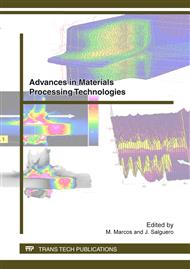p.121
p.127
p.133
p.139
p.145
p.151
p.157
p.163
p.169
Influence of Cutting Conditions on Temperature Rise, Feed Force and Cutting Torque when Drilling Bone
Abstract:
Surgical procedures that affect the human bone structure often entail drilling operations of bone. The post-operative evolution of these interventions is conditioned largely by the damage generated during the operation. The aim of this study was to determine clearly the influence of the cutting conditions on temperatures and forces when drilling bovine cortical bone, in the interests of further optimization of cutting conditions to minimize the generated damage. The infrared thermography technique and a piezoelectric dynamometer were employed as measurement devices. It was observed that the main parameter affecting temperatures was the feed per tooth. The temperatures obtained were lower when drilling with high feed per tooth, even though an opposite effect was noticed on the feed force and torque, with an increase of them. From the experimental results, prediction models of temperature rise, feed force and cutting torque were created, in order to predict the response based on the selected cutting conditions.
Info:
Periodical:
Pages:
145-150
Citation:
Online since:
April 2012
Authors:
Price:
Сopyright:
© 2012 Trans Tech Publications Ltd. All Rights Reserved
Share:
Citation:


